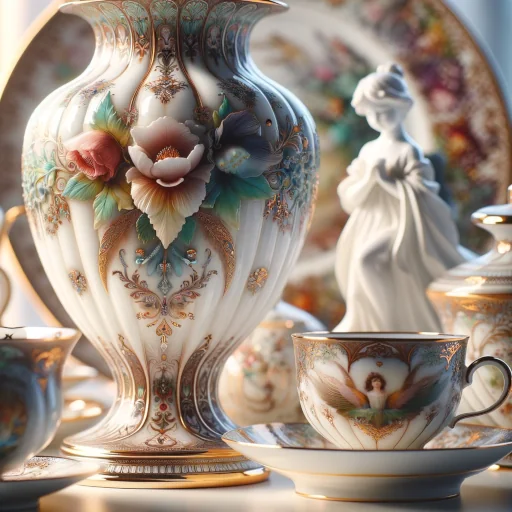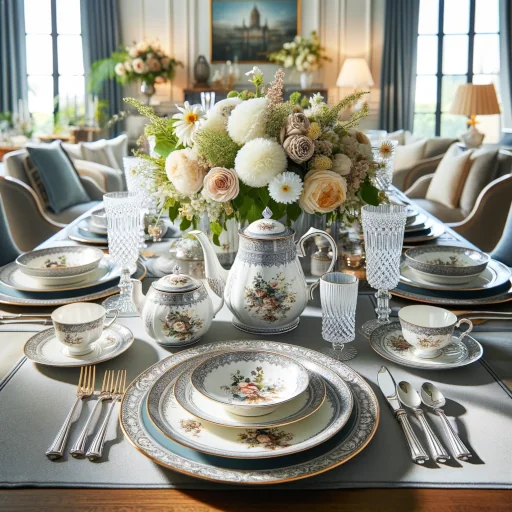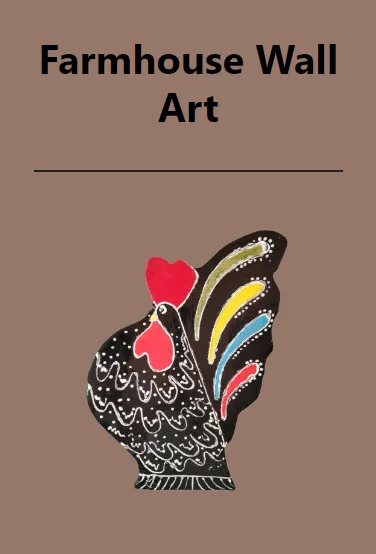It’s a high-quality porcelain made from bone ash, kaolin, and feldspathic material. Known for its strength, translucency, and whiteness, bone china is a popular choice for tableware and decorative items. Developed in 18th-century England, it has a rich history and is prized for its elegance and durability.
Bone china stands out in the world of ceramics for its unique blend of beauty, strength, and history. Originating in England during the 18th century, it quickly became renowned for its superior quality and elegant appearance.1
| Aspect | Details |
|---|---|
| Historical Development | Originated in England in the 18th century. |
| Composition and Characteristics | Made of bone ash, feldspathic material, and kaolin. |
| Ethical Considerations | Use of animal bones raises animal welfare concerns. |
| Environmental Impact | Energy-intensive manufacturing and chemical usage. |
| Alternatives | Fine porcelain, vitrified china, recycled glass products. |
| Historical and Cultural Context | Origin in China’s Ming Dynasty; refinement in England. |
| Comparison with Other Ceramics | Differences from fine china and porcelain. |
| Modern Applications and Aesthetics | Used in dinnerware, decorative items, and tea sets. |
| Authenticating and Valuing | Tips on identifying genuine bone china and its value. |
Historical Development
- Birth in England: The journey of bone china began in the 18th century. Its creation was a significant milestone in the world of ceramics, offering a stronger and more translucent alternative to existing porcelain.
- Global Recognition: Over time, bone china gained international fame. Today, it’s celebrated worldwide for its quality and aesthetic appeal, gracing tables from Europe to Asia.
Bone china’s blend of tradition and elegance makes it a timeless choice in ceramics, cherished for both its history and its enduring beauty.
Composition and Characteristics of Bone China
Materials and Properties
Bone china’s distinct composition is key to its remarkable properties. Let’s delve into its ingredients:
- Bone Ash: This is the game-changer. Derived from animal bones, primarily cow bones, bone ash gives bone china its unique translucency and whiteness.
- Feldspathic Material: This component contributes to the strength and durability of the material, ensuring bone china can withstand regular use.
- Kaolin: A type of clay, kaolin is responsible for the overall structure and adds to the strength, ensuring the fine, delicate appearance doesn’t compromise the durability.
These materials work in harmony, giving bone china its celebrated characteristics of translucency, strength, and a distinctive creamy whiteness.
Ethical Considerations
Bone china, as you might know, gets its name and unique qualities from the bone ash that’s mixed into the clay. Now, this is where things get a bit controversial. Those bones, they typically come from animals, and this doesn’t sit well with everyone. Especially today, when more people are conscious about animal rights and looking for cruelty-free options.
- Animal Rights Concerns – The process of making bone china involves the use of bones, which are typically sourced from animals. For individuals who are advocates for animal rights, this raises concerns about the treatment of animals and the ethics of using animal parts in products.
- Cruelty-Free Preferences – In today’s consumer market, there’s a growing demand for products that are cruelty-free, meaning they are made without harming animals. This shift in consumer preferences is driven by a broader awareness of animal welfare issues and a desire to make more ethical choices in purchasing.
- Vegetarian and Vegan Lifestyles – For vegetarians, vegans, and others who avoid using animal products for ethical or dietary reasons, the use of animal bones in bone china is in direct conflict with their values and lifestyle choices.
- Sustainability and Environmental Concerns – Some people are concerned about the sustainability of using animal products and the environmental impact associated with it. They might prefer materials that are more eco-friendly and have a lesser environmental footprint.
The thing is, in the pottery community, we need to have these conversations, even if they’re uncomfortable. It’s important to consider where our materials come from and the impact they have, not just on our art but on the wider world. And for consumers, it’s about making informed choices.
The good news is, with advancements in materials and a growing awareness, we’re seeing more alternatives to traditional bone china that maintain similar qualities without the use of animal products. It’s all about evolving with the times and respecting different viewpoints, which, in my opinion, is what true craftsmanship is all about.
The Alternatives
- Fine Porcelain – This is one of the closest alternatives to bone china. Fine porcelain, made without bone ash, offers a similar aesthetic with its delicate appearance and translucency. It’s a popular choice for those seeking a cruelty-free option without compromising on quality.
- Vitrified China – Vitrified china is a type of ceramic that has been fired at high temperatures to achieve a glass-like, non-porous quality. While it’s heavier than bone china, it’s incredibly durable and resistant to chipping, making it a practical alternative.
- Luminous Porcelain – This is a newer type of porcelain that has been engineered to have a similar luminous quality to bone china. It’s typically made with a mix of materials like glassy minerals to achieve its distinctive shine and translucency.
- Recycled Glass Products – While not exactly mimicking bone china, recycled glass products offer an environmentally friendly and unique alternative for tableware. They can be crafted to achieve a high level of elegance and beauty.
- Biodegradable Plastics – In more casual dining settings, biodegradable plastics made from natural materials like corn starch can be an alternative. While they don’t offer the same aesthetic, they’re an eco-friendly choice.
- Advanced Synthetic Materials – Research is ongoing in developing advanced synthetic materials that can replicate the qualities of bone china. These materials aim to offer the same feel and look while being completely animal-free.
Environmental Impact of Production
Energy-intensive
The process of making it is quite energy-intensive. You’ve got to fire those kilns at super high temperatures to get the right quality and finish.
I’m not just talking a little warm-up. These kilns have to reach temperatures up around 1,200 to 1,450 degrees Celsius. That’s hot enough to turn bone into ash and vitrify the clay, which is what gives bone china its strength and that characteristic translucent quality.
Now, maintaining these high temperatures isn’t like running your average oven. It requires a significant amount of energy. In many cases, these kilns are running on electricity or gas, and they need to keep at these high temperatures for hours. This kind of prolonged, intense energy use contributes substantially to the kiln’s carbon footprint, especially if the energy comes from fossil fuels.
To give you a bit more perspective, the energy consumption for firing a kiln to these temperatures is far greater than that used in firing earthenware or even regular porcelain. It’s one of the reasons why bone china is often more expensive, not just the materials, but the energy costs are higher.
Animal Bones in Bone China
When I talk about bone china, the crucial ingredient is bone ash, typically made from animal bones, most commonly cattle bones. Now, sourcing these bones is a process in itself. Firstly, there’s the question of where these bones come from. Ideally, they’re a byproduct of the meat industry, meaning no animals are specifically harmed for bone china. But even then, there’s a whole supply chain involved in getting these bones from slaughterhouses to the manufacturers who turn them into ash.
The process of converting bones to bone ash isn’t simple. The bones first need to be cleaned thoroughly, which usually involves boiling them to remove any remaining meat or tissue. Then they’re put through a high-temperature calcination process. This is where the bones are heated to temperatures around 1,000 degrees Celsius, which turns them into that fine, white ash. This process, while necessary to produce the desired quality of bone china, requires additional energy and has its own environmental footprint.
There’s also the consideration of the chemicals used in cleaning and processing the bones. These chemicals, if not managed properly, can have environmental and health implications.
Then, you’ve got transportation. These bones, and later the bone ash, often travel long distances from source to factory. This transportation contributes to the overall carbon footprint of the production process.
Historical and Cultural Context of Bone China
Origins and Global Spread
Bone china’s story is a fascinating journey through history and cultures:
- Ming Dynasty Roots: Its inception dates back to China’s Ming Dynasty, where the first iteration of porcelain containing animal bones emerged. This early form laid the groundwork for what would become bone china.
- Refinement in England: In the 18th century, English craftsmen, notably in Staffordshire, refined this technique, creating the bone china we know today – a blend of bone ash, kaolin, and feldspathic material.
Cultural Significance
- In China: Originally valued for its strength and translucency, it was a symbol of craftsmanship and innovation.
- In England and Europe: Post refinement, it became a hallmark of luxury and elegance in tableware and decorative items.
- Global Influence: From Europe to the Americas and beyond, bone china’s allure spread, becoming a coveted item in various cultures, reflecting sophistication and history.
Throughout different eras, bone china has held a special place, evolving from a novel invention to a symbol of cultural refinement and global exchange in the ceramic arts.
Comparison with Other Ceramics

Bone China vs. Fine China and Porcelain
Bone china, fine china, and porcelain each have unique characteristics:
Material Composition
- Bone China: Made with bone ash, kaolin, and feldspathic material, it’s known for its strength and translucency.
- Fine China: Lacks bone ash, resulting in a starker white color.
- Porcelain: Similar to bone china but without bone ash, typically thicker and less translucent.
Color and Translucency
- Bone China: Creamy and translucent, allowing light to pass through.
- Fine China: Brighter white, less translucent.
- Porcelain: Opaque and often denser.
Impact on Use
- Bone China: Ideal for elegant tableware, often used in formal settings due to its delicate appearance and strength.
- Fine China: Preferred for its pure white elegance, suited for both formal and casual dining.
- Porcelain: Known for its durability, it’s commonly used in both household and commercial settings.
These differences influence not just the aesthetic appeal but also the practicality and setting in which each type of ceramic is best suited.
Modern Applications and Aesthetics of Bone China

Design and Use in Contemporary Settings
Bone china continues to be a versatile and cherished material in various modern contexts:
Contemporary Uses
- Dinnerware: From everyday meals to formal dinners, bone china adds elegance.
- Decorative Items: Statues, vases, and art pieces made from bone china bring sophistication to interiors.
- Tea Sets: Tea enthusiasts often prefer bone china for its delicate yet durable nature.
Aesthetic Diversity
- Color Range: From classic white to bold hues, bone china accommodates a spectrum of tastes.
- Pattern Variability: Floral, geometric, abstract – bone china’s surface is a canvas for diverse artistic expressions.
- Adaptability: It blends seamlessly with both traditional and contemporary design aesthetics, making it a favorite among modern designers.
This aesthetic and functional versatility ensures bone china’s continued relevance and appeal in today’s design landscape.
Authenticating and Valuing Bone China
Identifying Genuine Bone China
Authenticating bone china revolves around its distinct characteristics:
- Translucency Test: Hold a piece up to light. Real bone china allows light to pass through, revealing a certain level of transparency.
- Texture and Color: Genuine bone china typically has a smoother texture and a unique creamy color.
Factors Contributing to Value
- Age: Older pieces, especially antiques, often hold higher value.
- Manufacturer: Renowned brands like Wedgwood or Royal Doulton add prestige and value.
- Rarity and Condition: Limited edition pieces or those in pristine condition are highly sought after.
These factors combined help in determining the authenticity and worth of bone china items.
Complementary Insights and Further Reading
For those seeking a deeper understanding of bone china, the article “The Beauty and Strength of Bone China” is a must-read. It delves into:
- Durability: How bone china balances delicacy with strength.
- Artistic Applications: Explore its use in various artistic forms.
- Care Tips: Practical advice on maintaining its beauty.
This article complements the current discussion by offering practical insights and a detailed examination of bone china’s artistic importance, enriching your appreciation and knowledge of this exquisite material.
Conclusion and Summary
Bone china’s enduring appeal lies in its unique blend of history, artistry, and functionality. From its roots in ancient China to its refinement in England and global spread, it represents a fusion of cultural craftsmanship. Today, bone china continues to symbolize elegance and durability in both traditional and modern settings.
As you encounter or own pieces of this exquisite material, take a moment to appreciate the rich history and meticulous craftsmanship behind each item. Bone china is not just a ceramic; it’s a story of innovation, art, and enduring beauty.
Ethical and Environmental Aspects
Ethical Considerations
- Use of Animal Bones: The production of bone china involves animal bones, raising concerns about animal welfare and ethical sourcing. The use of animal bones in bone china production has sparked ethical discussions. Since bone ash, derived from animal bones (typically cow bones), is a key ingredient, concerns arise about animal welfare and how these bones are sourced. There’s an increasing demand for transparency in sourcing practices, ensuring that bones are obtained as by-products of the meat industry rather than through methods that may harm animal welfare. This shift towards ethical sourcing reflects a broader movement in manufacturing industries to prioritize sustainability and ethical considerations in their production processes.
- Industry Response: Manufacturers are increasingly aware and are exploring ethical sourcing methods for bone ash.
Environmental Impact
- Manufacturing Process: Bone china production involves high energy consumption and environmental emissions. The manufacturing process of bone china is energy-intensive, primarily due to the high temperatures required for firing the ceramics. This process leads to significant energy consumption and the emission of greenhouse gases. Additionally, the production involves various chemical processes, which can result in environmental pollution if not properly managed. In response to these environmental concerns, some manufacturers are adopting more sustainable practices, such as using renewable energy sources, improving efficiency in kilns to reduce energy consumption, and implementing waste management systems to minimize the environmental impact of their production processes.
- Sustainability Initiatives: There’s a growing focus on reducing the carbon footprint, recycling waste, and employing eco-friendly practices in the industry.
Meesh’s Interview With Ed Shears
Ed Shears is a distinguished expert in the field of ceramics, particularly renowned for his extensive knowledge of pottery. With a career spanning over three decades, Shears has contributed significantly to both the academic and practical aspects of ceramic arts. He holds a degree from the University of Alabama in Birmingham, and has authored several influential papers. Shears is also known for his collaborations with various other artists, advising on sustainable practices and innovative design approaches. His insights are highly valued in the ceramics community, blending historical expertise with a vision for the future of the industry.
History and Evolution: “Mr. Shears, can you describe how bone china has evolved from its origins to its current form?”
“Bone china has come a long way since its 18th-century English beginnings. Initially, it was a solution to match the quality of Chinese porcelain. Over time, it became a symbol of luxury in Europe. Today, it has evolved beyond tableware to include a wide range of decorative items, reflecting both traditional craftsmanship and modern design sensibilities.”
Artistic Significance: “What makes bone china particularly suitable for artistic and decorative purposes?”
“The unique translucency and whiteness of bone china provide a perfect canvas for intricate designs and patterns. Its ability to be both delicate and strong allows artists to experiment with forms that are both aesthetically pleasing and functional.”
Sustainability Efforts: “In your experience, how is the industry addressing the ethical and environmental concerns associated with bone china production?”
“The industry is increasingly conscious of its environmental impact. Many manufacturers are now focusing on ethical sourcing of bone ash and implementing more energy-efficient production methods. There’s a growing trend towards using eco-friendly materials and reducing waste, signifying a shift towards more sustainable practices.”
Future Trends: “Where do you see the future of bone china in terms of design and manufacturing innovations?”
“The future of bone china lies in the balance of tradition and innovation. We’re seeing more designers merging contemporary aesthetics with traditional methods. In manufacturing, there’s a push towards greener technologies and materials. Bone china will continue to evolve, embracing both its rich heritage and modern environmental responsibilities.”
FAQ: What is Bone China?
Is bone china still made of bones?
Yes, bone china still contains bone ash, typically made from cow bones. This component is essential for its unique translucency and strength.
What is special about bone china?
Bone china is unique for its high levels of whiteness and translucency, combined with exceptional strength and chip resistance. It’s also known for its elegant and delicate appearance.
Is bone china better than porcelain?
“Better” depends on the context. Bone china is generally finer and more translucent than porcelain, making it more suitable for delicate tableware, whereas porcelain is denser and often used for a broader range of items.
Is bone china worth anything?
Yes, bone china can be quite valuable, especially pieces from renowned manufacturers or antique collections. Its value depends on factors like age, rarity, and condition.
Footnotes
- Wardell, Sasha. Porcelain and Bone China. United Kingdom: Crowood Press Limited, 2020. ↩︎





